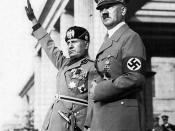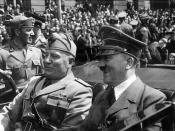" Mussolini successfully established a totalitarian dictatorship in Italy."
Q: How far do you agree with this statement about Italian politics in 1924-39?
My answer:
In the twentieth century, both Communist and Fascist states had been defined as being 'Totalitarian'. During the 1930's this was usually to distinguish the parties clearly from democracies, like Britain and France, and then once the Second World War had ended, to distinguish the Soviet Union from western democracies. Many historians have tended to avoid using the term 'totalitarian', as there were so many different variations between different forms of totalitarian state. After the Matteotti crisis had taken place in 1924, it had been Mussolini who had first publicly used the term 'totalitarian', which he had used to describe his tough policy towards opponents. What most people would expect a totalitarian dictatorship to be like is a form of government that permits no rival loyalties or parties, and usually demands a total submission of the individual to the requirements of the state, and this seems to be the way in which Mussolini carried out his 'totalitarian' dictatorship in Italy in the years 1924-39.
Mussolini pursued Italian politics by setting it in the context of intending to destroy all opposition to his regime and to ensure that the future 'fascist' and 'Italian' would eventually come to mean the same. His ideas of fascist values being embraced by all Italians and of every Italian subordinate to the state became the most enduring strand to fascist philosophy. The main intention was to involve every Italian in the fascist cause of 'national greatness', and to not only create a fascist elite within the state. Fascism's aims were to be 'nationalistic', and not just a party movement, and this required the state to control important areas of economic activity and...


